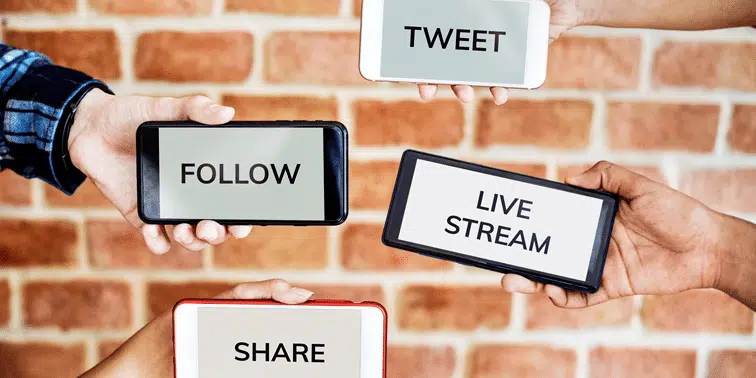Social Media
Explore expert insights into social media trends with Croydon’s leading web design and digital marketing company. Tailored for SME business owners in South London and Surrey, our category page is the go-to resource for enhancing your digital presence and engagement
Part 2: Social media channels for businesses
As we mentioned before on our previous blog, it’s important that both large and small businesses use the social media channels that’s appropriate for their target audience. With that in mind, here’s another list of social media channels with tips you need to consider when improving your social media presence.
A visually appealing channel, Instagram is an excellent way for businesses to showcase products and services using images and videos. Not only are you able to create posts, you’re also able to extend post reach using relevant hashtags and by tagging other Instagram users to encourage sharing.
Instagram also has a ‘Stories’ feature, which allows you to post videos and images that vanish after 24 hours – although you can keep Stories as highlights with a prominent position just under your profile. This is a great way to give your audience some insight into what may happen on a day-to-day basis. Why not read our blog and find out more about Instagram stories.
As Facebook and Instagram are connected, it’s possible for you to use the data gained from Facebook on Instagram. With this information, you’re able to target the same niche.
Instagram also gives users the opportunity to turn existing posts into promoted ads. This saves you time creating ads and makes them look more organic. Instagram lets you target ads to the relevant groups of people based on location, their likes, and even behaviours.
Still, Instagram’s algorithm does leave much to be desired. As once again, posts aren’t shown chronologically but instead they’re shown based on the algorithm and what users will be interested, making it easy for users to miss posts.
Also, other than in your bio, it’s not possible for you to place links on posts so it does make link building quite troublesome.
TikTok
TikTok is a relatively new video sharing app that allows users to create, share and discover short innovative videos. These videos are usually accompanied by edits and special effects that are incorporated in the app.
Having exploded over the last five years, after the initial 2016 launch, TikTok has amassed 689 million active users excluding China (where it’s called Douyin), TikTok is the most downloaded app on the Apple store as of 2019. Taking that into consideration, it’s clear that joining TikTok should have some merit for businesses, especially those that focus on business to consumer (B2C) transactions.
TikTok can be a great way for businesses to improve their relationship with consumers. Examples of this include Dominos in Ireland, with its “We Got This” campaign which resulted in more than 800,000 views and a 100% video completion rate, with engagement rate reaching 4.84% with an abundance of praise from viewers. These results were achieved using TikTok In-Feed Ads. This method of advertising allows you to integrate video content onto your audiences “For You” page as they scroll.
TikTok is also a great way for businesses to keep in tune with teens and young adults, with 41% of users being between 16-24 years old. Companies can research their audience’s likes and interests and create innovative content that resonates with their customers.
However, limitations of TikTok include the fact that their analytics are only available for 28 days. This means that companies will have to conduct performance tracking regularly, which can be especially time consuming for small businesses.
YouTube
YouTube is currently the second most popular social media platform with 2.3 billion users worldwide and, as of 2019, 79% of the internet users have a YouTube account. As an online video platform, YouTube makes it easier for content creators to share their creations with a much larger audience.
Businesses can use YouTube to share video content with their target audience free of charge.
giving you space to experiment with different types of video to see what connects with your audience. Although, uploading videos may be free but the creation of the video may not be, so this cost also needs to be considered. Video creation can also be time consuming, particularly for those that are new at it.
YouTube also allows you to monetise your videos. To do this, you must apply and be accepted into YouTube’s partnership programme. Through this programme you can make money when ads are displayed on your video, selling merchandise on your channel and when a YouTube Premium subscriber watches your content you get a percentage of their fee.
YouTube can also help SEO, as adding links to your YouTube profile and video descriptions creates backlinks to your website. This will increase website traffic and increase your domain authority which refers to the strength of your website that allows it to rank on SERPs.
However, there are some drawbacks. Whilst YouTube gives you the opportunity to advertise yourself on videos from other creators, the same can also be done to you. You don’t have control over which ads may be added to your video. It’s possible that ads that have the potential to damage your brand may run, and it’s even possible for competitors to add their own ads to your videos.
With YouTube videos and in fact any videos you create, you must always consider copyright. For example, music and images will always carry some form of copyright so content either needs to be unique or from authorised stock images as YouTube can easily remove your video for copyright infringement
As a digital marketing agency in London, we’re able to assist you in creating video content. Visit our digital marketing video tips blog for more on how to make your video great, and book a free consultation if you’d like to know more about our content marketing expertise.
Snapchat
Snapchat is a mobile app that centres around communicating using images and videos that only last for a short amount of time. Snapchat currently has 253 million daily active users worldwide, a 22% increase from the previous year. Although Snapchat is available for all ages, statistics show that 71% of Generation Z use it daily.
If your target audience is between the ages of 13-24 Snapchat’s a useful tool for engaging with them. With features such as filters and stickers, businesses can interact with their audience in a way that entertains.
Snapchat also has a discover feature, that allows users to explore content from users they may not follow. This can be used by businesses to increase their brand awareness and reach, as Snapchat users access the app more than 18 times a day with 20/30 minutes spent on it a day.
A disadvantage of using Snapchat is the time limit on the photos and videos. Snapchat videos have increased from 10 seconds to a maximum of 60 seconds. This may look like an advantage, but a video that’s too long may lose your audience’s attention. Also, the content, such as stories and messages, disappear after 24 hours with no way to get it back.
Unlike other social media channels, Snapchat doesn’t give you the option of resharing content. This is only possible by taking screenshots or saving the content and reposting it yourself, which can be time consuming.
Social Media agency Croydon
Although there’s a lot of information to take in, hopefully this has helped you to consider what social media channels suit your business the best.
Incorporating social media into your marketing strategy can raise brand awareness and online presence. Visit our blog for tips on how you can improve social media presence.
If you feel you need support in getting your business noticed on social media, then get in touch with Smart Cow Marketing to discuss your needs further.
Part 1: Social media channels for businesses
There are 420 billion active social media users. Taking this into consideration, it’s important for businesses, large or small, to use the social media channel that’s right for their target audience.
Social media is a great way to extend reach and increase brand awareness, but it’s not a one size fits all approach and there can be pros and cons. So, we’ve gathered a list of some of the top social channels with tips you need to consider when improving your social media presence.
Twitter is a social media platform that allows you to connect with others using tweets. These tweets are short snippets containing up to 280 characters. These real-time updates can also consist of images, videos and even polls.
With over 192 million active users, Twitter can be a great way to share news of products and services. Twitter makes sharing easier with its retweet function, which gives users the opportunity to share someone else’s tweet on their own timeline. You’re also able to use hashtags, giving you the opportunity to extend the reach of a post.
Like most social channels, you can also advertise on Twitter which also provides an effective way at targeting specific audiences using location, language, keywords and even social handles.
Nonetheless, compared to other networks, Twitter’s growth is lower. The introduction of algorithms has also impacted the timeline. Twitter is less of a lead generator but should be seen more as a place to build brand awareness and a way to provide quality links back to your website, which will help you rise in search engine results pages (SERPs). Furthermore, gaining a following on Twitter requires a lot of time and effort, a privilege not every business may have. But, if you’re a start-up business looking to increase brand awareness, Twitter is a channel to use in conjunction with others.
Facebook is a popular social networking site that allows users to connect with each other by sharing updates with images, videos, articles and even music.
As a social media giant, it’s no surprise that businesses want to grow their social presence on Facebook.
With over 2 billion monthly users, Facebook is a good place for businesses to begin increasing brand awareness. Not only are you able to reach your potential target audience, but you can also easily set up your business profile quickly, so you have immediate presence.
Regard Facebook as a search engine, if your company is present, it provides comfort to someone looking for your products or service. Plus, it provides those all-important quality links to your website when you share a post which is key for link building for search engine optimisation (SEO) purposes.
If you’re looking to go beyond organic social with a paid for campaign, then Facebook ads are also relatively cheap when compared to traditional advertising methods such as print.
Features such as ‘Page Insights’ allow you to analyse how your audience interact with your content, and ‘Audience Insights’ gives you a better understanding of who your audience is. Both these tools, when used in conjunction, give you the ability to tailor your content to your audience.
However, disadvantages of using Facebook for business include issues with posts not getting the views you desire due to the nature of the algorithm. Instead of showing posts chronologically, the algorithm deems what is more relevant to the user. So, you won’t be in total control of who sees your post and may in fact miss out on views because of this.
Used by a vast number of businesses to grow their professional network, LinkedIn is an exceptional marketing tool when used appropriately.
You have the option of creating both a company and individual profile. We’d recommend a business creating a company profile to benefit from features including ‘about us’, the ability to share updates, polls and most recently LinkedIn Product Pages. All innovative ways to ensure your audience is kept up to date with your business activities. However, this doesn’t mean you shouldn’t create an individual account. So, if you’re not already registered on LinkedIn then we’d highly recommend that your sales, business development and marketing colleagues have their own profiles set up.
Ultimately LinkedIn is all about networking, so this provides a great way to reach your target audience in a personal way.
With over 30 million companies on LinkedIn and 675 million users, LinkedIn’s a good place for businesses to increase brand awareness. Tools like LinkedIn Sales Navigator also allow users to find the relevant profiles using search filters, helping you find relevant leads.
LinkedIn is also a great way to improve your website’s SEO, due to the fresh new content that’s constantly being uploaded, and LinkedIn’s high domain authority. This combination means that when people are using search engines like Google, LinkedIn pages are likely to come up on the organic search pages.
Even so, one drawback to be taken into consideration is that building a successful LinkedIn profile can be time consuming. This could be one of the reasons why only ¼ of LinkedIn users are active. Another reason for inactivity is that since everyone is on there doing the same thing, there’s a large influx of spam messages. It may take a while for you to distinguish between spam and messages you should respond to.
Clubhouse
With an initial release of March 2020, we’ve seen Clubhouse increase from 600,000 in December 2020 to 10 million weekly active users. This is proof that Clubhouse is steadily becoming more popular. An invitation only social media channel that allows you to network with others by creating audio ‘Rooms’ in which you can discuss topics. This exclusive new app has featured tech geniuses, such as Elon Musk, and entertainers, like award winning rapper Drake, alike.
Clubhouse gives businesses the opportunity to connect with their audience and other businesses through conversation. As a speaker, you’re able to lead conversation and provide useful insight into your chosen topic. This is an excellent way to showcase your knowledge and awareness with your audience.
As a listener, you’re able to learn from the market leaders that you may not otherwise have had access to. You may even have the chance to get to ask your own questions during these conversations. This makes Clubhouse a great way to network with other likeminded individuals.
Still, Clubhouse does have its drawbacks. Due to the growing popularity of the app, it’s becoming more difficult to find ‘Rooms’ that are helpful. The smaller ‘Rooms’ are more interactive, and easier to digest and share information. This contrasts with the larger ‘Rooms’ where communication becomes more difficult as more and more people want to speak and there are often a lot of cases of people speaking over each other.
Some information may need to be taken with a pinch of salt rather than as fact, as the persona people portray may not match their reality. You may often find that when you do your research on some speakers, they lack credibility on certain topics.
Social Media agency Croydon
Although there’s a lot of information to take in, hopefully this has helped you to consider what social media channels suit your business the best.
Incorporating social media into your marketing strategy can raise brand awareness and online presence. Visit our blog for tips on how you can improve social media presence.
If you feel you need support in getting your business noticed on social media, then get in touch with Smart Cow Marketing to discuss your needs further.
Improve social media presence
When it comes to social media marketing it may feel like you’ve already heard all the top tips you need to hear; be consistent, target specific audiences, use hashtags, stick to relevant platforms. While these are all important factors to consider, and we have plenty of digital marketing resources to help (see below), it is equally important to make your social media marketing strategies original.
Here are some smart quick tips to take on board for your social channels:
1. Engage
Using social media for your business is not as simple as shouting out what your business has to offer. Make sure you post and engage with others on the platforms whether it is other businesses or clients.
2. Get link building
We would recommend creating a content marketing plan with key dates plotted out such as national days of interest related to your businesses products or services. This provides a hook and a way to create timely news for blog posts based on this plan. This ensures regular content on your website which saves you time thinking about what to write.
When you share content in a social post add a link back to your website.
Let’s not forget that using social for your business also helps with search engine optimisation (SEO) as it provides a quality link back to your website.
3. Groups
Join community groups, industry specific groups and relevant associations to meet like-minded people. This allows you to network with other businesses or to target a specific audience.
4. What is trending?
Keep up to date with current affairs relevant to your sector and audience. Creating social posts around what is trending in the news or the platform you are using makes your content relatable to the viewer. It helps to position you as a thought leader in your field.
5. Incorporate videos
Videos are booming right now. On Facebook, video content has jumped to 258% since 2016, and Tweets with a video attracting 10 x more engagement than those without.
Videos can be created simply on smartphones, however here’s our tips for being on camera if you are creating videos yourself and more about using video for business.
Social media agency Croydon
If you need support with setting up your social media platforms, understanding your target audience or conducting paid for campaigns such as Facebook ads, get in touch with Smart Cow. As a social media marketing company, we work with small businesses in Croydon and across London on digital marketing campaigns that can help drive traffic to their website.



